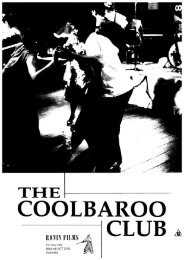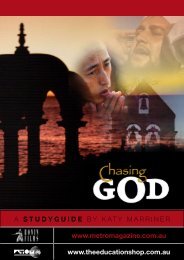Click here to download POZIERES Study Guide - Ronin Films
Click here to download POZIERES Study Guide - Ronin Films
Click here to download POZIERES Study Guide - Ronin Films
Create successful ePaper yourself
Turn your PDF publications into a flip-book with our unique Google optimized e-Paper software.
<strong>POZIERES</strong><br />
58<br />
Pozieres A <strong>Study</strong> <strong>Guide</strong><br />
Libby Tudball<br />
Introduction<br />
Between July and August, 1916, the small village of<br />
Pozieres in northern France became the centre of one<br />
of the bloodiest battles of the Great War and the key<br />
<strong>to</strong> the success of the Battle for the Somme. Pozieres<br />
was s<strong>to</strong>rmed by Australian soldiers and captured from<br />
the German forces who had invaded and taken over<br />
the French village. In a few short weeks, Australia<br />
suffered 23,000 casualties and 10,000 lives were lost<br />
<strong>to</strong> claim this tiny patch of earth. Sadly, by the end of<br />
August the village had been destroyed. The battles <strong>to</strong><br />
reclaim the terri<strong>to</strong>ry for the French nation were <strong>to</strong><br />
become legendary.<br />
The heroism of Australians who fought at Pozieres<br />
and elsew<strong>here</strong> on the Western Front is still honoured<br />
and remembered <strong>here</strong> and in France. Pozieres<br />
remains one of the most famous names from the<br />
Great War. Most of the soldiers who survived World<br />
War 1 are now dead, yet their sacrifices and s<strong>to</strong>ries<br />
are still being researched and represented in film,<br />
text, on web sites and in other ways. The film<br />
Pozieres takes the viewer back in time, and uses<br />
his<strong>to</strong>rical re-enactment, still pho<strong>to</strong>graphs, paintings<br />
and his<strong>to</strong>rical archive materials <strong>to</strong> pass on the s<strong>to</strong>ry<br />
of these Australian experiences during the Great War.<br />
Before Watching the Film<br />
Work through the following background reading, activities<br />
and questions <strong>to</strong> develop your understanding of<br />
World War 1 and what happened at Pozieres.<br />
The Great War<br />
The Great War began on the 4 th of August 1914, when<br />
Britain declared war on Germany as a result of the<br />
German invasion of France and neutral Belgium. Britain,<br />
France, Australia and New Zealand became allies<br />
Curriculum Links:The film and<br />
materials in this guide will have<br />
interest and relevance for senior<br />
secondary students of Studies of<br />
Society and Environment, His<strong>to</strong>ry,<br />
English, Drama and Media Studies.<br />
Younger students may find some<br />
scenes disturbing.<br />
in their efforts against Germany, Austria-Hungary<br />
and Turkey (the central powers). The German army<br />
advanced within 120 kilometres of Paris. The Allied<br />
effort <strong>to</strong> fight back the German advance is the focus<br />
of Pozieres.<br />
In 1915, one million <strong>to</strong>ns of British ships were sunk by<br />
German submarines and the German army used poison<br />
gas as a weapon for the first time in the his<strong>to</strong>ry of warfare.<br />
In 1916, the Germans launched the drive <strong>to</strong>wards<br />
Paris along the Somme River Valley in a series of battles<br />
that was <strong>to</strong> include the Battle of Pozieres.<br />
The Village of Pozieres Before the Conflict<br />
■ Locate Pozieres on a map of France.<br />
Official war pho<strong>to</strong>graphers worked <strong>to</strong> provide authentic<br />
pic<strong>to</strong>rial narratives of the Great War. Look at the<br />
pictures of Pozieres taken by British correspondents<br />
before and after the war which were presented <strong>to</strong> the<br />
Australian government. Look at the pho<strong>to</strong>graph and<br />
key <strong>to</strong> the pho<strong>to</strong>graph of the village of Pozieres on the<br />
23 rd of June, 1916.<br />
■ How would you describe the village and surrounding<br />
areas?<br />
Look at the pho<strong>to</strong>graph of Pozieres taken on the 7 th of<br />
August after the bombardment.<br />
■ How would you describe the area?
Aerial view of the village of Pozieres before the conflict<br />
■ How would you describe the village of Pozieres in<br />
both scenes?<br />
■ What kind of warfare was used <strong>to</strong> cause the devastation<br />
shown in the pho<strong>to</strong>?<br />
■ What do you think might have happened <strong>to</strong> the<br />
local people?<br />
■ How do the pho<strong>to</strong>graphs help explain the dramatic<br />
casualties at Pozieres?<br />
■ What were conditions like for the treatment of casualties?<br />
The Western Front<br />
The line of trenches dug by the German army that<br />
stretched from the North Sea <strong>to</strong> the Swiss border<br />
became known as the Western Front. It was the largest<br />
man made construction the world had ever seen.<br />
■ Visit http://www.worldwar1.com/maps/anzwfbig.gif<br />
<strong>to</strong> locate key sites on the Western Front.<br />
■ Find out why it was so difficult for the allies <strong>to</strong><br />
break through the Front.<br />
Australian Involvement<br />
in World War 1<br />
Most Australians reacted <strong>to</strong> news of the outbreak of<br />
war with great enthusiasm and many thousands were<br />
keen <strong>to</strong> enlist. During the first two weeks of the war<br />
17,000 men volunteered <strong>to</strong> join the Australian Imperial<br />
Forces in Vic<strong>to</strong>ria and New South Wales alone. T<strong>here</strong><br />
was a belief that the war would be over by Christmas,<br />
and many eager young men volunteered quickly, afraid<br />
they might miss out on the action.<br />
Read through the following reactions and extracts.<br />
Whatever happens, Australia is part of the<br />
Empire <strong>to</strong> the full. Remember that when the<br />
Empire is at war, so is Australia at war.<br />
Prime Minister Cook, Argus, 1914<br />
For good or ill, we are engaged with the mother<br />
country in fighting for liberty and peace. It<br />
is no war of aggression upon which Bri<strong>to</strong>ns<br />
have entered, but one in defence of small<br />
nations threatened with humiliation … if not<br />
The Village of Pozieres After the Conflict<br />
<strong>POZIERES</strong><br />
59
<strong>POZIERES</strong><br />
60<br />
Daniel Mannix<br />
with extinction, and above and beyond everything,<br />
our armies will fight for British honour.<br />
Sydney Morning Herald edi<strong>to</strong>rial, 6 th August, 1914<br />
I was the eldest of six children in our family<br />
on a not <strong>to</strong>o rich dairy farm near Toowoomba<br />
in 1915. T<strong>here</strong> was a severe drought and things<br />
were not <strong>to</strong>o good on the farm. The only <strong>to</strong>pic<br />
of talk was the war and it seemed the proper<br />
thing <strong>to</strong> do was enlist, however I think it was the<br />
spirit of adventure and seeing things that was<br />
the prime mover.<br />
Extract from Citizen To Soldier 1<br />
In 1914, 96% of Australians were of British descent.<br />
In spite of the fact that ever increasing numbers of<br />
Australians were born in Australia and felt a sense<br />
of loyalty <strong>to</strong> Australia, many still saw Britain as the<br />
Mother Country. Australia’s parliament, legal and education<br />
system were all based on British models. School<br />
students studied British, not Australian his<strong>to</strong>ry. In the<br />
first decade of the twentieth century, people in Australia<br />
were nervous about Russian, Japanese, French<br />
and German intentions in the Asia and Pacific regions.<br />
They were keen <strong>to</strong> support Britain in the hope they<br />
would receive protection in return should the need<br />
arise.<br />
■ What does the information you have read <strong>here</strong> tell<br />
you about why Australians became involved in the<br />
war?<br />
■ Do some library research <strong>to</strong> find out more about<br />
why Australians volunteered <strong>to</strong> join up.<br />
■ Not everyone was enthusiastic. Investigate reasons<br />
why some people did not wish <strong>to</strong> be involved.<br />
■ T<strong>here</strong> were complicated diplomatic events contributing<br />
<strong>to</strong> the outbreak of war in Europe. Conduct some<br />
further library research <strong>to</strong> build a more complete picture<br />
of the causes of the war.<br />
The War Drags On<br />
Christmas 1914 and 1915 came and went, and the<br />
German army held firm on the Western Front. Australians<br />
were shocked by the disastrous Gallipoli campaign<br />
in Turkey in April 1915, w<strong>here</strong> 7,600 lives were<br />
lost, but t<strong>here</strong> was immense pride in the courage and<br />
persistence of the ANZAC soldiers. The British command<br />
then decided <strong>to</strong> move these troops on <strong>to</strong> France.<br />
■ Do some library research <strong>to</strong> find out more about<br />
the Gallipoli Landing. Why was it so disastrous?<br />
■ What legends and s<strong>to</strong>ries are t<strong>here</strong> about the heroism<br />
of the ANZACS at Gallipoli?<br />
■ What happened in the course of the war from 1917<br />
<strong>to</strong> 1918?<br />
■ How did the war end?<br />
After Watching the Film<br />
The Battle of Pozieres<br />
■ To build a s<strong>to</strong>ry and timeline of what happened at<br />
Pozieres, ask each class member <strong>to</strong> jot down the key<br />
events in sequence as they watch the film. Then as a<br />
class write up the events as a s<strong>to</strong>ry board.<br />
■ In a class discussion, talk about the impressions<br />
you have of what it was like for the AIF soldiers at<br />
Pozieres.<br />
■ Imagine you are a war correspondent writing<br />
reports on what happened at Pozieres. Write a series<br />
of front page news articles for the Daily Telegraph of<br />
16 th July <strong>to</strong> 7 th August, 1916 about what happened at<br />
Pozieres, based on the information and pho<strong>to</strong>s in the<br />
study guide and what you have seen in the film. You<br />
could refer <strong>to</strong> descriptions of the AIF soldiers you see<br />
in the film, <strong>to</strong> extracts from the Telegraph at the time<br />
and other information you can gather.
Aerial view of the village of Pozieres after the conflict<br />
■ What are your impressions of Haig’s views on the<br />
severity of the losses?<br />
■ Why do you think he ordered the Battle of the<br />
Somme <strong>to</strong> continue?<br />
Soldiers’ S<strong>to</strong>ries<br />
Pozieres tells its s<strong>to</strong>ry through the eyes of particular<br />
soldiers and their families. As a class, or in small<br />
groups, discuss each of these characters and the fac<strong>to</strong>rs<br />
that made their experience in the war both similar<br />
and different. Use the following points and questions<br />
<strong>to</strong> launch your discussion:<br />
Thomas Gardiner was a thirty-three year old miner<br />
from Kerang. The voice-over tells us that ‘he survived<br />
the war but not the peace’.<br />
■ What does this mean?<br />
■ Why do you think he was motivated <strong>to</strong> join up at<br />
first?<br />
■ Why did his sister Mabel have a different opinion?<br />
■ Why did he die?<br />
■ Did he eventually understand Mabel’s point of view<br />
about the war?<br />
Eric Liddie was a twenty-two year old dental apprentice<br />
from North Sydney. He survived the war but lost<br />
his leg.<br />
■ What compensation was he awarded for the loss of<br />
his leg? Do you think this was fair?<br />
Matthew and Steve Grant were two brothers from<br />
Sydney who fought at Pozieres.<br />
■ What happened <strong>to</strong> the brothers?<br />
Horace Ward was a labourer from 62 York Street, Port<br />
Melbourne. He died at Pozieres.<br />
(Adolf Hitler, a twenty-seven year old German soldier<br />
who was considered odd by his comrades, survived the<br />
same battle w<strong>here</strong> Horace was killed.)<br />
■ How were parents at home in Australia <strong>to</strong>ld of the<br />
loss of their loved ones?<br />
■ What made Horace’s death particularly tragic for<br />
his father?<br />
Daniel Perry was a thirty-one year old carpenter from<br />
West Adelaide with a wife and son.<br />
<strong>POZIERES</strong><br />
61
<strong>POZIERES</strong><br />
62<br />
General Haig<br />
■ What happened <strong>to</strong> David?<br />
■ What support would the government have provided<br />
for his wife and child?<br />
■ What do we learn in the film <strong>to</strong> suggest t<strong>here</strong> might<br />
have been a different outcome for Daniel with better<br />
medical facilities?<br />
Bert Taylor was a twenty-one year old s<strong>to</strong>ckman from<br />
Queensland. He survived the war and became a successful<br />
author and an advocate for Aboriginal rights.<br />
■ What impressions does he give of Pozieres?<br />
Thomas was a twenty-two year old watchmaker from<br />
Fremantle.<br />
■ It could be said that Thomas reveals an ugly side of<br />
soldiers’ behavior. Do you agree?<br />
Jim O’Brien was a thirty-one year old shearer from<br />
Win<strong>to</strong>n, Queensland.<br />
■ What is Jim’s attitude <strong>to</strong> the war?<br />
■ What happens <strong>to</strong> Jim?<br />
David Pearson was an Aboriginal soldier who was<br />
wounded twice and received a military medal. He was<br />
killed in 1918.<br />
■ Why wasn’t David regarded as an Australian citizen?<br />
Trench Warfare<br />
Many thousands of AIF and enemy soldiers spent<br />
months in the trenches in France from 1916 – 1918.<br />
The German commanders ordered their troops <strong>to</strong> dig<br />
trenches <strong>to</strong> protect them from advancing French, British<br />
and Australian forces. The sad truth was that the<br />
trench warfare and ‘over the <strong>to</strong>p’ charges achieved<br />
very little.<br />
■ How do you think the trenches were built?<br />
■ What advantages and disadvantages could you suggest<br />
for trench warfare?<br />
■ Why were t<strong>here</strong> ‘duck boards’ at the base of the<br />
trench?<br />
■ What hardships would the soldiers on both sides<br />
have experienced in the trenches?<br />
■ Find out more about trench warfare on the web<br />
sites http://www.worldwar1.com/reflib.htm<br />
http://www.hellfirecorner.com/<br />
Australian Attitudes <strong>to</strong> British<br />
Authority<br />
■ What impressions does the film give of the Australians’<br />
attitudes <strong>to</strong> the British authorities? The reenacted<br />
scene in the film showing AIF soldiers in the<br />
Middle East could be used for evidence in this answer.<br />
One million Allied soldiers, including nearly 60,000<br />
Australians, were killed in battle. Sir Douglas Haig’s<br />
critics believe he was responsible for many unnecessary<br />
deaths.<br />
■ From what you see in the film, what is your opinion<br />
of Haig? Do some library research <strong>to</strong> find out more<br />
about him. Visit http://www.co.uk/FWWhaig.htm <strong>to</strong><br />
find out more about the General who was responsible<br />
for many of the decisions <strong>to</strong> send Allied soldiers in<strong>to</strong><br />
battle on the Western Front.<br />
■ What were Haig’s impressions of the AIF?
The Home Front<br />
The Great War had a tremendous impact on the lives<br />
of many thousands of Australians on the home front.<br />
As thousands of husbands, sons and fathers rushed off<br />
<strong>to</strong> enlist, the lives of the women, children and relatives<br />
left behind changed dramatically. It was not uncommon<br />
for three or four members of a family <strong>to</strong> enlist.<br />
Many women had <strong>to</strong> scrimp, save and take on extra<br />
work in an effort <strong>to</strong> get by.<br />
■ What different reactions do you see <strong>to</strong>wards the<br />
war through the eyes of the various characters on the<br />
home front?<br />
■ What wartime fac<strong>to</strong>rs shaped the lives of Australians<br />
who remained at home?<br />
■ Do further library research <strong>to</strong> find out more about<br />
life on the home front during the Great War.<br />
The Conscription Debate<br />
(Note: conscription during the Great War meant the<br />
forced enlistment of young men in<strong>to</strong> the army, with<br />
penalties for those who refused including imprisonment.)<br />
By 1916 the number of Australian volunteers for the<br />
AIF was declining; at the same time t<strong>here</strong> were increasing<br />
casualties on the Front. The British government<br />
requested more men. Prime Minister Billy Hughes’<br />
decision <strong>to</strong> introduce referendums on the conscription<br />
of soldiers <strong>to</strong> fight in the war in 1916, and again in 1917,<br />
caused bitter divisions in Australian society.<br />
The results of the first referendum were:<br />
YES vote 1,087,332<br />
NO vote 1,158,881<br />
Majority for NO 71,549<br />
■ What do these statistics tell you about the attitudes<br />
of Australians during the war?<br />
■ What do you find out in the film about the arguments<br />
and campaigns for and against conscription?<br />
■ In the film, you see a re-enactment of the incident<br />
w<strong>here</strong> an egg is thrown at Prime Minister Hughes. Why<br />
did this happen?<br />
■ Why do you think the senior sergeant refused <strong>to</strong><br />
charge the offender?<br />
■ Why did this incident lead <strong>to</strong> the formation of the<br />
first Federal Police Force?<br />
■ Do some further research on the conscription<br />
debates. Class members could look at conscription<br />
posters and poetry, and investigate the views of<br />
people including Daniel Mannix and John Curtin,<br />
groups such as the IWW, people from different religions<br />
and unionists. Note the various reasons why they<br />
voted for or against conscription.<br />
Dressing station near Pozieres<br />
<strong>POZIERES</strong><br />
63
<strong>POZIERES</strong><br />
64<br />
■ The ‘Blood Vote’ poem is believed <strong>to</strong> have been<br />
critical in persuading many women <strong>to</strong> vote against<br />
conscription. Read the poem and talk about what it<br />
means. What is your opinion of the power of the<br />
poem?<br />
■ Conduct a class debate <strong>to</strong> argue for and against<br />
conscription.<br />
■ What was the outcome of the second conscription<br />
referendum in 1917?<br />
Attitudes <strong>to</strong> Germans in<br />
Australia During the War<br />
Sections of the film provide insights in<strong>to</strong> what happened<br />
<strong>to</strong> Germans in Australia during the Great War.<br />
■ What does the film tell you about the treatment of<br />
German nationals living in Australia during the war?<br />
■ How do you think the men and women would have<br />
felt about what was happening?<br />
■ Do you think t<strong>here</strong> was any real basis for fear of<br />
German people who had lived in Australia, in some<br />
cases, for many years?<br />
■ Find out more about what life was like for the men<br />
who were sent <strong>to</strong> internment camps.<br />
■ Why do you think German place names were<br />
changed?<br />
The End of the War<br />
At the end of the Great War, 60,000 Australian soldiers<br />
had been killed out of a <strong>to</strong>tal Australian population of<br />
only five million. Australia went through a period of<br />
great social, economic and political division. The war<br />
shocked people all over the world. It had caused so<br />
much senseless loss of life, with as many as ten million<br />
soldiers killed. Vast areas of farmland and forest in<br />
Europe were destroyed, and many Australians came<br />
home physically crippled and psychologically devastated.<br />
■ In one scene in the film, you see footage of a shellshocked<br />
soldier. How can you explain the shell-shock<br />
so many soldiers experienced?<br />
■ Why do you think the medical professions found it<br />
difficult <strong>to</strong> treat these conditions?<br />
■ In what ways would it have been particularly traumatic<br />
for soldiers requiring plastic or reconstructive<br />
surgery?<br />
■ For some soldiers, the return home was easier than<br />
for others. Why did some soldiers cope better with the<br />
return <strong>to</strong> Australia?<br />
■ How long was it before Australia was involved in<br />
warfare again and why?<br />
Media Studies<br />
■ How would you describe the genre of this film?<br />
■ Write a critical review of Pozieres for a film magazine.<br />
■ How do you think the combination of factual presentation<br />
of issues and re-enactment works in the film?<br />
■ What emotional reactions does the film generate?<br />
■ Make a list of all the different source materials<br />
used as images in the making of this film.<br />
■ List and comment on how links are made between<br />
the different themes.<br />
Further Activities<br />
The war diaries of Reg Part provide us with great<br />
insights in<strong>to</strong> what life was like at Pozieres. He<br />
describes the battle scene as ‘hell with a vengeance’<br />
and records his s<strong>to</strong>ry of being gassed in the trenches.<br />
Visit http://www.scotch.sa.edu.au/<br />
WarDiary/RegPart.htm#France <strong>to</strong> read Reg’s s<strong>to</strong>ry.
Visit the Australian War Memorial <strong>to</strong> complete further<br />
research on Australians in wartime and <strong>to</strong> do a virtual<br />
<strong>to</strong>ur of the memorial. http://www.awm.gov.au/<br />
References: Books<br />
J. Bassett, The Home Front: 1914 – 1918, Inquiring<br />
in<strong>to</strong> Australian His<strong>to</strong>ry series, Oxford University Press,<br />
Melbourne, 1993.<br />
Commonwealth Department of Veterans’ Affairs, A<br />
<strong>Guide</strong> <strong>to</strong> the Battlefields, Cemeteries and Memorials of<br />
the Gallipoli Peninsula, 1998.<br />
T. Curran, Across The Bar: The S<strong>to</strong>ry of Simpson, The<br />
Man with the Donkey – Australia’s and Tyneside’s<br />
Great Military Hero, Brisbane, 1994.<br />
B. Gammage, The Broken Years: Australian Soldiers in<br />
the Great War, Penguin, Melbourne, 1975.<br />
B. Hoepper, D. Hut<strong>to</strong>n & W. Hindsley, Changing the<br />
World: Inquiries in Modern His<strong>to</strong>ry, Jacaranda, Brisbane,<br />
1990.<br />
J.M. Main, Conscription: The Australian Debate 1901 –<br />
1970, Cassell, Melbourne, 1970.<br />
M. McKernan, Australians in Wartime, Nelson, Melbourne,<br />
1983.<br />
A.M. Nixon, Somew<strong>here</strong> in France: Letters <strong>to</strong> Home –<br />
The War Years of Sgt. Roy Whitelaw, 1 st AIF, Five Mile<br />
Press, 1989.<br />
L.L. Robson, Australia and the Great War, Macmillan,<br />
Melbourne, 1969.<br />
Libby Tudball (ed.), Australian Perspectives, Jacaranda,<br />
Brisbane, 1991.<br />
<strong>Films</strong><br />
Gallipoli – directed by Peter Weir, written by David<br />
Williamson, 1981<br />
Community Organizations<br />
■ Department of Veterans’ Affairs in your state or<br />
your federal Member of Parliament<br />
■ Commemorative Activities Section<br />
Department of Veterans’ Affairs<br />
PO Box 21<br />
Woden ACT 2606<br />
Fax (o6) 289 4849<br />
Email cas@dva.ausgovdva.telememo.au<br />
World Wide Web: www.dva.gov.au<br />
■ the RSL in your state<br />
■ museums in your state<br />
■ The Australian War Memorial<br />
Anzac Parade<br />
Campbell ACT<br />
Telephone (06) 243 4211<br />
Pozieres is available through <strong>Ronin</strong> <strong>Films</strong>:<br />
PO Box 1005<br />
Civic Square ACT 2608<br />
Phone: (02) 6248 0851<br />
Fax: (02) 6249 1640<br />
<strong>POZIERES</strong><br />
65


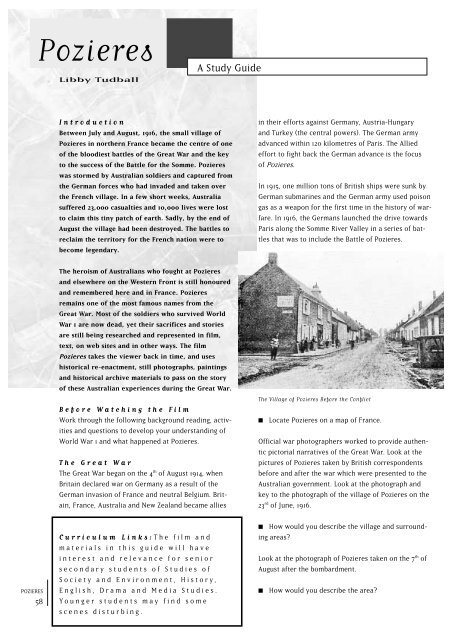
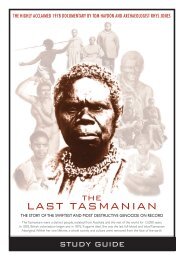


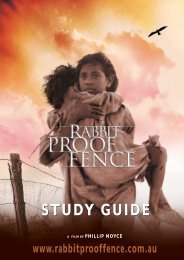

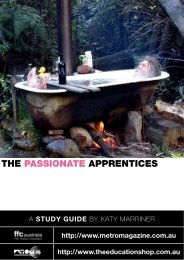
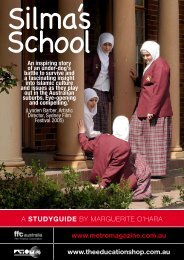
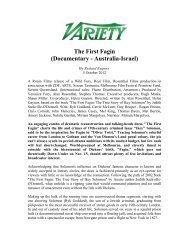

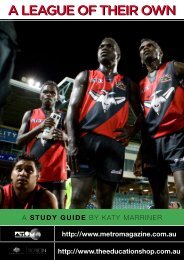
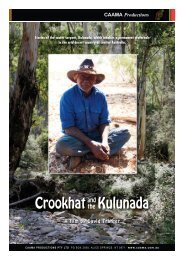
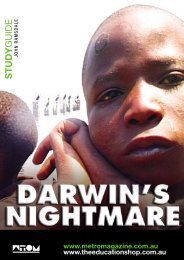
![to download FROHE OSTERN! [HAPPY EASTER!] - Ronin Films](https://img.yumpu.com/33740736/1/184x260/to-download-frohe-ostern-happy-easter-ronin-films.jpg?quality=85)
